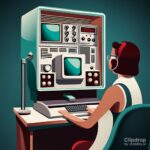(1975) The Homebrew Computer Club
“Established in 1975, The Homebrew Computer Club became an incubator for the personal computer revolution, fostering an environment that birthed groundbreaking technology and future industry leaders. Its open, collaborative atmosphere and commitment to innovation spurred the development of products and technologies, such as the Apple I, that continue to shape our technological landscape.”
~ Robert Lavigne, The Digital Grapevine
The Incubator of the Personal Computer Revolution
In the midst of the technological boom that was the 1970s, a small group of computer enthusiasts gathered in the heart of Silicon Valley, unknowingly laying the foundation for the personal computer industry. The Homebrew Computer Club, established in 1975, became an incubator for the development of the personal computer and a breeding ground for future technology leaders. In this article, we will explore the origins, accomplishments, and lasting impact of the Homebrew Computer Club on the world of technology.
Origins and Early Meetings
The Homebrew Computer Club was founded by Gordon French and Fred Moore, two technology enthusiasts who sought to create a forum for computer hobbyists to share ideas, exchange information, and collaborate on projects. The first meeting took place on March 5, 1975, in French’s garage in Menlo Park, California. From that moment on, the club convened every two weeks, attracting an increasingly larger and more diverse group of members.
Membership and Notable Figures
The Homebrew Computer Club quickly gained a reputation for its open, collaborative atmosphere and its passion for innovation. Membership was informal and open to anyone interested in computers. Over time, the club attracted some of the brightest minds in the emerging personal computer industry. Among the most notable members were Steve Jobs and Steve Wozniak, who would later go on to co-found Apple Inc.
Other key figures included Lee Felsenstein, who designed the Processor Technology Sol-20 computer and later founded the Community Memory Project; Bob Marsh, co-founder of Processor Technology; and Bill Gates, co-founder of Microsoft. These individuals, along with many others, used the Homebrew Computer Club as a platform to exchange ideas and share their inventions, shaping the course of the personal computer revolution.
Innovations and the Birth of Apple
The Homebrew Computer Club provided a fertile environment for technological innovation. Members were encouraged to experiment, tinker, and share their creations with the group. One of the most significant accomplishments to emerge from the club was the development of the Apple I computer by Steve Wozniak.
Wozniak, an engineer at Hewlett-Packard at the time, was inspired by the club’s atmosphere and the recent release of the MITS Altair 8800, often considered the first personal computer. Wozniak designed the Apple I in 1976 and showcased it at a Homebrew Computer Club meeting. With the encouragement and support of fellow club members, Wozniak partnered with Steve Jobs to establish Apple Computer, marking the beginning of one of the most successful technology companies in history.
The Legacy of the Homebrew Computer Club
The Homebrew Computer Club disbanded in 1977, but its influence on the personal computer industry and the broader technology landscape is indisputable. The club served as an incubator for ideas and a catalyst for innovation, fostering the development of groundbreaking products and technologies. Many of the companies and products that emerged from the club, such as Apple and the Sol-20 computer, continue to shape the way we interact with technology today.
Moreover, the Homebrew Computer Club played a pivotal role in democratizing access to computers and promoting the idea that computers could be tools for individuals, not just large corporations or research institutions. By providing a forum for hobbyists to collaborate and share their creations, the club helped to foster a new era of personal computing, paving the way for the widespread adoption of computers in homes and businesses around the world.
Conclusion
The Homebrew Computer Club, though short-lived, played a significant role in the development of the personal computer industry and the careers of numerous technology industry leaders. Its open, collaborative atmosphere and commitment to innovation fostered groundbreaking products and technologies that continue to shape our world today. The club’s lasting legacy serves as a reminder of the power of collaboration and the importance of fostering environments where passionate individuals can come together to share ideas and drive progress. As we continue to push the boundaries of technology and explore new frontiers, the story of the Homebrew Computer Club offers inspiration for the next generation of inventors, entrepreneurs, and technology enthusiasts. The Homebrew Computer Club may have disbanded, but its spirit of innovation and collaboration lives on, ensuring its enduring influence on the world of technology.
FAQs
- What was the Homebrew Computer Club and why was it significant?
The Homebrew Computer Club was an informal group of computer enthusiasts founded by Gordon French and Fred Moore in 1975. It served as an open forum for sharing ideas and collaborating on computer-related projects. The club played a significant role in the personal computer revolution, fostering the development of groundbreaking technology and nurturing future industry leaders, such as Steve Jobs and Steve Wozniak. - How did the Homebrew Computer Club influence the birth of Apple?
Steve Wozniak, co-founder of Apple, was a member of the Homebrew Computer Club. Inspired by the club’s collaborative atmosphere and the MITS Altair 8800, Wozniak designed the Apple I and showcased it at a club meeting in 1976. Encouraged and supported by fellow club members, Wozniak partnered with Steve Jobs to establish Apple Computer, which would later become one of the most successful technology companies in history. - Who were some notable members of the Homebrew Computer Club?
Notable members of the Homebrew Computer Club included Steve Jobs and Steve Wozniak, co-founders of Apple; Lee Felsenstein, who designed the Processor Technology Sol-20 computer; Bob Marsh, co-founder of Processor Technology; and Bill Gates, co-founder of Microsoft. These individuals, among others, used the club as a platform to exchange ideas and share inventions, greatly influencing the personal computer revolution. - What innovations were sparked by the Homebrew Computer Club?
The Homebrew Computer Club’s environment encouraged innovation and the exchange of ideas, leading to the development of significant technologies such as the Apple I. Other innovations included the Processor Technology Sol-20 computer, designed by member Lee Felsenstein. These inventions, born out of the club’s collaborative ethos, played a pivotal role in shaping the personal computer industry. - What is the legacy of the Homebrew Computer Club?
Despite disbanding in 1977, the Homebrew Computer Club’s influence on the technology landscape is profound. It served as an incubator for technological ideas and a catalyst for innovation, fostering the development of groundbreaking products and companies that continue to shape our interaction with technology today. The club played a pivotal role in democratizing access to computers, fostering the idea that computers could be personal tools, not just for corporations or research institutions, and set the stage for the widespread adoption of computers globally.

